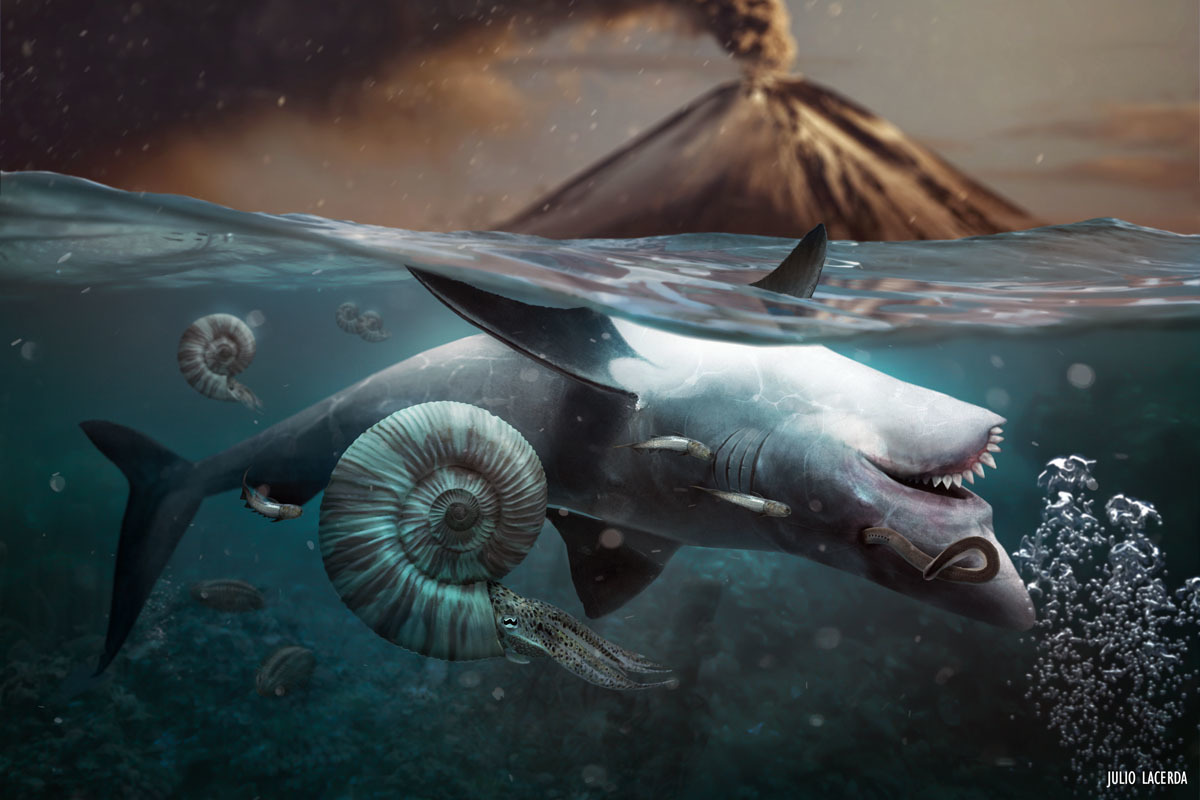Two important types of animals dominated land during the Permian; synapsids and sauropsids. Synapsids, which had one temporal opening in their skulls, are thought to be the ancestors of mammals. A well-known synapsid alive during the Permian was Dimetrodon, which is known for the large sail on its back that is held up by bony spines. Dimetrodon is commonly referred to as a dinosaur or as an ancestor of dinosaurs when in fact, it is more closely related to mammals than to dinosaurs and went extinct during the Permian, around 40 million years before the appearance of the earliest dinosaurs.
Sauropsids had two temporal openings in their skulls and were the ancestors of reptiles such as dinosaurs and birds. Synapsids, according to the fossil record, seemed to be more dominant than sauropsids. However, sauropsids seemed more capable of surviving the conditions that caused the Permian extinction and became more dominant than synapsids after the Permian.
In the shallow oceans, reefs were large and life among the reefs was diverse. Ammonites and brachiopods were very common. Little is known about life in the deeper parts of the Panthalassic Ocean because most fossil evidence is deeply buried, but cartilaginous fishes such as sharks and rays were common and true bony fishes were becoming more common.
At the end of the Permian, conditions became unsuitable for most life and about 95% of marine species were eliminated as well as 70% of terrestrial species in a very short period of time, in geologic terms. It was also one of the few known mass extinctions of insects. Many plant species also went extinct. There is fossil evidence that there were once vast coniferous forests in modern day Europe that died out in the Permian. Fungi were not impacted as severely as other organisms, likely because of the abundance of dead plant and animal material available for their consumption.
Because of the enormous number of species that became extinct, the P-Tr mass extinction is nicknamed “The Great Dying” and its impacts are still noticeable today. For example, bivalves, which were not a large part of the Permian marine fauna, were able to dominate the oceans over other organisms as many gastropod and brachiopod species were killed. Bivalves are still very common in today’s oceans.
The cause of the P-Tr extinction is still debated by scientists. It isn’t clear whether it happened gradually over many thousands of years, or if it happened because of sudden catastrophic events.
One possible cause of the extinction could have been a large volcanic event that produced flood basalts, also known as Siberian Traps. The eruption covered around 2 million square kilometers with lava and was one of the largest volcanic events in Earth’s history. The eruptions may have caused large amounts of carbon dioxide to be released into the atmosphere and caused a large-scale global warming effect of more than 10°C on land and around 8°C on the ocean surface in a short period of time. The eruptions may have also caused acid aerosols and dust clouds to be released into the atmosphere which blocked out the sun and prevented photosynthesis from occurring, effectively causing many food chains to collapse.
Another possible cause, but happening gradually over millions of years, was the forming of the supercontinent Pangaea. When Pangaea was finally formed in the middle of the Permian, there was a substantial decrease in the area of shallow marine environments. These shallow environments were the most productive parts of the oceans and produced much of the oxygen on the planet. Without them, the planet may have seen a decrease in the amount of oxygen available. These areas were also home to many organisms that were the base of food chains. A decrease in the area of these organisms’ habitat meant a decrease in the availability of food for the majority of marine organisms. The formation of Pangaea may have also had an effect on ocean circulation which in turn affected nutrient circulation in the oceans, and may have also affected global weather patterns.
Another possible cause of the extinction is an impact event, much like the meteor that famously killed the dinosaurs at the end of the Cretaceous Period. The Permian extinction appears to have happened in two or three pulses of extinction. Two or more separate impacts could have possibly accounted for these pulses. Some possible evidence for impact events are meteorite fragments in Australia, rare shocked quartz in both Australia and Antarctica, and craters in Australia. If a meteor did impact Earth during this time, it more than likely landed in the ocean. Since the ocean floor is recycled by tectonic activity every 200 million years, any evidence of the impact is likely gone./p>
The most likely scenario is that the Permian mass extinction was caused by a combination of many events which together made the Earth unsuitable for most life. It is important for scientists to try to understand the conditions during the Permian mass extinction because it will help them to better understand the climate crisis we are currently facing and possibly help take measures to avoid another mass extinction event in the future.
References
Encyclopedia Britannica: Permian Period
Encyclopedia Britannica: Permian extinction
Bagley, Mary, 2014, Permian Period: Climate, Animals & Plants, Live Science.

Jackson
Chambers
Writer





